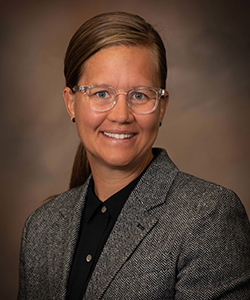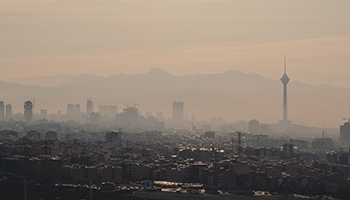 A phenomenon that has people in Salt Lake City coughing and wheezing every winter is the “temperature inversion,” when a layer of warmer air is held above cooler air, trapping pollution closer to the ground. It creates a haze of pollutants that get caught in the Salt Lake Valley, leaving residents with unhealthy air.
A phenomenon that has people in Salt Lake City coughing and wheezing every winter is the “temperature inversion,” when a layer of warmer air is held above cooler air, trapping pollution closer to the ground. It creates a haze of pollutants that get caught in the Salt Lake Valley, leaving residents with unhealthy air.
It’s a trend that happens in many cities, and University of Utah chemical engineering associate professor Heather Holmes (pictured) wants to find out exactly what the sources are of the harmful pollutants that get trapped in an inversion and what impact they have on our health. She and researchers from the University of California, Riverside; University of Nevada, Reno; and George Mason University have received a five-year, $2.6 million grant from the National Institute of Environmental Health Sciences. University of Utah chemical engineering assistant professor Kerry Kelly and U School of Computing professor Ross Whitaker are also involved in the project.
Holmes said she and the team of scientists want to examine the secondary pollutants caught in an inversion, namely the ammonium nitrate particles and organic carbon that are created from primary pollutants, the emissions from sources such as cars, wildfires, and fossil fuel combustion. These primary pollutants undergo chemical reactions to create secondary pollutants in the form of liquid or solid particles in the atmosphere.
 “One example of something unique that we’re looking at is natural gas combustion,” Holmes said. “When you go past a natural gas power plant, you can see that it does not emit large amounts of particulate. Natural gas combustion primarily emits gas-phase pollutants. Then those gases can be transported downwind and undergo chemical reactions where they become particles. We are interested in knowing how much these gasses contribute to nitrate concentrations during winter in the western U.S.”
“One example of something unique that we’re looking at is natural gas combustion,” Holmes said. “When you go past a natural gas power plant, you can see that it does not emit large amounts of particulate. Natural gas combustion primarily emits gas-phase pollutants. Then those gases can be transported downwind and undergo chemical reactions where they become particles. We are interested in knowing how much these gasses contribute to nitrate concentrations during winter in the western U.S.”
The researchers will be developing an air quality model that apportions both primary and secondary PM2.5 (particulate matter 2.5 micrometers and smaller) and use the estimates from this model in a large 12-city epidemiologic study. Cities include Salt Lake City, Denver, Las Vegas, Sacramento and others. They hope to determine the sources of these secondary pollutants and how these particles could adversely affect people’s health. Better understanding this could lead to air-quality managers creating more effective regulations to protect human health.
“Nobody has studied the health impacts of the sources of the secondary particulate matter during these temperature inversions,” Holmes said. “Studies have looked at total particulate matter impacts but not the impact of specific species like the nitrates and organic carbon and their sources.”
Human anatomy belongs to the biological sciences. Human anatomy is a science that studies the origin, development, external and internal structure, functional characteristics of a living person. Human anatomy aims to describe the shape, macroscopic structure, topography of organs, taking into account the sexual, individual, constitutional characteristics of the organism, as well as 250 word essay for nursing phylogenetic and ontogenetic moments of development. The study of the structure of a person is carried out from the standpoint of a whole organism. Anatomy also draws on data from anthropology – the science of man. Anthropology examines in a person not only age, sex and individual characteristics, but also racial, ethnic, professional, studies social influences, finds out the factors that determine the historical development of a person. Thus, biology considers humans from an evolutionary perspective.